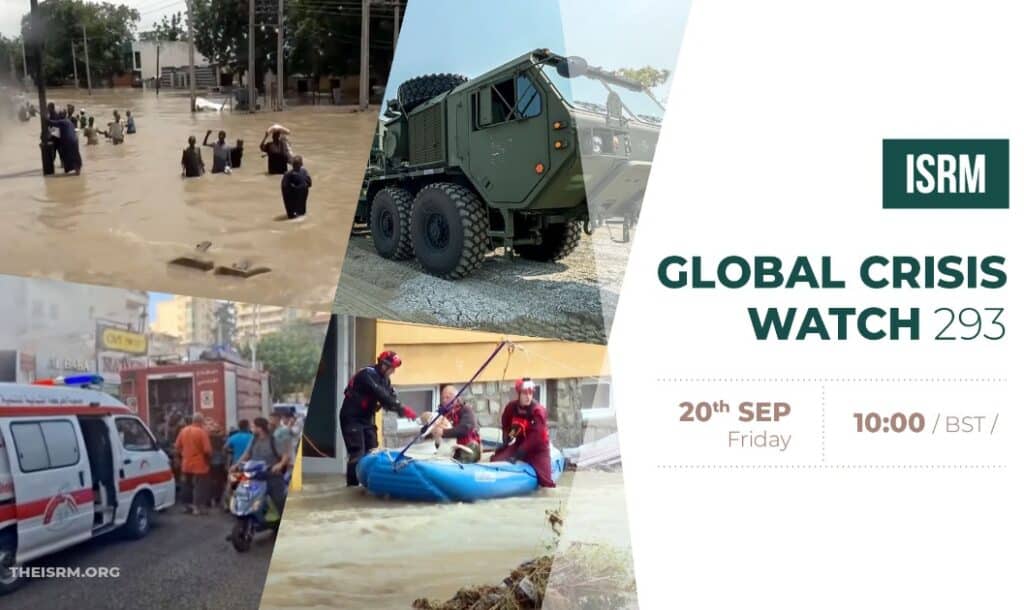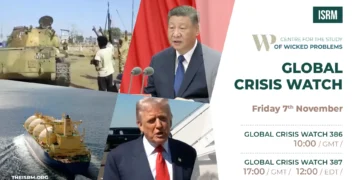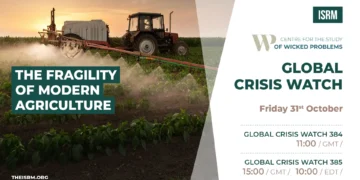The Institute of Strategic Risk Management (ISRM) has announced Global Crisis Watch 293, taking place on Friday, September 20 at 10:00 BST. This week topics will include the recent deadly pager and walkie-talkie blasts in Lebanon, the Nigeria flooding crisis, amid Lagdo Dam discharges and regional instability, extreme weather in Europe and the Typhon missile system remaining in the Philippines for strategic testing, despite Chinese objection. Read more about the topics and register below.
Deadly pager and walkie-talkie blasts shake Lebanon amid Hezbollah-Israel tensions
A series of sophisticated attacks shook Lebanon as explosive devices hidden in pagers and walkie-talkies killed at least 32 people and injured thousands, including children, on September 12 and 13. The devices, reportedly smuggled into Lebanon months earlier, were used by Hezbollah members. Israel is suspected of orchestrating the attacks, with Defense Minister Yoav Gallant suggesting a “new era” in the conflict. Recent reports suggest that Israel may have strategically planted explosives to showcase its capacity to dismantle Hezbollah’s infrastructure and conduct targeted strikes within the organization’s residential areas. This purported action appears to circumvent any existing security management protocols that Hezbollah might employ. This maneuver is perceived as a demonstration of Israel’s technological and tactical superiority over Hezbollah. Hezbollah, vowing retribution, warned that Israel would face severe consequences, while Iran, whose ambassador was injured in the explosions, promised a response.
The attacks come amid a long-standing power struggle between Hezbollah, backed by Iran, and Israel, part of a broader regional conflict along the northern Israeli-Lebanese border. Hezbollah has relied on low-tech communication devices like pagers and walkie-talkies to avoid Israeli surveillance, but Israeli forces successfully infiltrated these devices, leading to the devastating blasts. While some suspect the attacks were meant to preempt Hezbollah’s discovery of this infiltration, the explosions have heightened tensions in Lebanon, particularly in Hezbollah-controlled areas.
The United Nations condemned the attacks, calling for an independent investigation, and accused Israel of violating international humanitarian law. Regional experts fear that this conflict could escalate into a broader war, as both Hezbollah and Israel have been engaged in low-level skirmishes in recent months. Israel’s shift of military resources toward the north further underscores the growing volatility.
Nigeria faces severe flooding crisis amid Lagdo Dam discharges and regional instability
The recent flood warnings in Nigeria highlight the severe impacts of water releases from the Lagdo Dam in Cameroon and the ongoing climate-related challenges in the region. After heavy rains in West and Central Africa, Cameroon announced controlled discharges from the dam to avoid excessive flooding downstream in Nigeria. Eleven Nigerian states along the Benue River are expected to be affected. The country has a history of flood-related disasters tied to these discharges, including the 2022 flood that claimed over 600 lives and caused $9 billion in damages.
In addition to the dam release, Nigeria is already grappling with floods in the north, where torrential rains recently led to a dam collapse near Maiduguri, displacing thousands. The floods caused a prison wall to collapse, allowing over 200 inmates to escape, compounding the local crisis. The region, particularly Borno state, already faces hardships from ongoing conflicts like Boko Haram, adding another layer to the humanitarian emergency. The International Rescue Committee (IRC) has warned of potential cholera outbreaks, given the poor sanitary conditions in displaced persons’ camps.
This flood crisis illustrates the broader issue of climate change’s intensifying impact across Africa, where extreme weather events have become more frequent, leading to mass displacement, widespread casualties, and significant agricultural losses.
Rising waters and raging fires: Central Europe faces extreme weather
Central Europe is facing unprecedented devastation as both deadly floods and wildfires wreak havoc across the region. In Poland, the town of Nysa was evacuated, with 44,000 residents forced to flee as rising river levels threatened to inundate the area. Volunteers and soldiers worked through the night, forming human chains to pass sandbags and reinforce riverbanks. With rivers still expected to peak, floodwaters have already claimed at least 23 lives across Poland, Romania, Austria, and the Czech Republic. The extensive damage, estimated to run into billions of dollars, has prompted appeals for EU financial aid, as governments struggle to rebuild.
Meanwhile, Portugal is battling one of its worst wildfire seasons in years, with seven fatalities, including three firefighters. More than 5,000 firefighters are on the front lines, trying to contain nearly two dozen blazes that have forced road closures and evacuations. The fires, exacerbated by low humidity and dry conditions, have disrupted travel and daily life as they spread across the country.
These simultaneous disasters underscore the growing threat of climate change across Europe, where extreme weather events are becoming more frequent and intense. Both floods and wildfires have displaced thousands, destroyed infrastructure, and left communities grappling with the aftermath. As emergency services work tirelessly, the need for long-term climate adaptation strategies becomes ever more urgent.
Typhon missile system remains in Philippines for strategic testing despite Chinese objections
The United States has decided to keep the Typhon missile system in the Philippines despite strong objections from China and Russia. Originally deployed earlier this year for joint military exercises, the system, which includes cruise missiles like the SM-6 and Tomahawk with ranges exceeding 1,600 km, remains stationed in northern Luzon, strategically positioned near the South China Sea and Taiwan Strait. This deployment marks the first time the Typhon system has been used in the Indo-Pacific region.
The U.S. and Philippine forces continue to conduct joint training with the Typhon, exploring its operational feasibility in the region. Philippine officials have indicated that there are no immediate plans for its removal, and discussions are ongoing regarding the system’s potential role in future conflicts. This move aligns with U.S. strategic interests in Asia, particularly in supporting Taiwan and countering Chinese influence.
China and Russia have condemned the deployment, accusing the U.S. of escalating regional tensions and fueling an arms race. The U.S. Army has described the deployment as a “historic first” and a significant enhancement of the U.S.-Philippines partnership. While the system’s presence was initially intended to be temporary, recent developments suggest that it may remain longer to assess its effectiveness and integration into regional defense strategies.
The U.S. and Philippine governments have not yet provided official statements on the system’s extended deployment, but the ongoing training and operational evaluations highlight the strategic importance of the Philippines in U.S. defense plans.
All this will be discussed, plus all the stories that are catching our attention wherever we live in the world. Feel free to join and add your voice to the conversation.
For more ISRM news, click here





